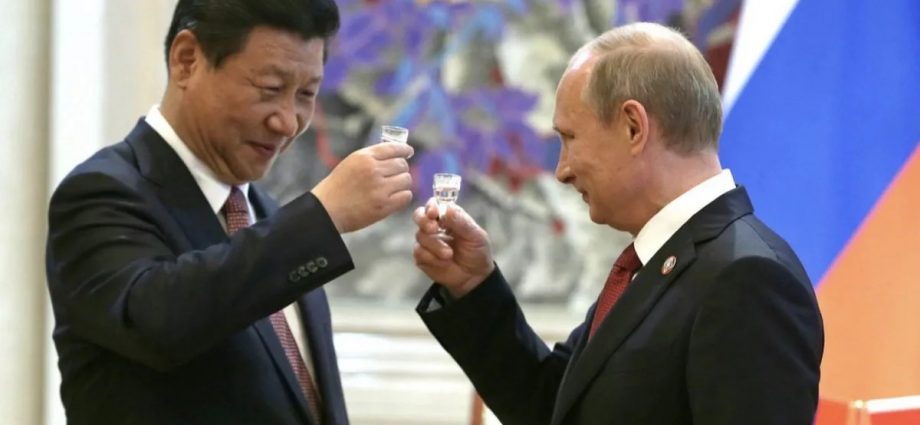
This week European Commission President Ursula von der Leyen and French President Emmanuel Macron are visiting China as part of an effort to influence Beijing’s foreign policy regarding Ukraine after Xi Jinping’s recent visit to Moscow.
China has positioned itself as a “neutral” player in the Russia-Ukraine conflict from the start, seeking to act as a mediator, while denying military assistance to Russia. Beijing maintains close ties with Moscow, stressing that it does not accept third-party “dictation” on how to conduct its own foreign affairs.
According to Chinese Foreign Minister Qin Gang, “the more unstable the world becomes, the more imperative it is for China and Russia to steadily advance their relations. With China and Russia working together, the world will have a driving force.”
One of the main purposes of Xi’s official visit to Moscow last month was to raise the comprehensive strategic partnership between the two countries to a new level, expand economic and trade cooperation, and send a signal to the West that China is independent in defining its own foreign policy in the context of the Ukrainian conflict.
For China and Russia, economic cooperation is not only a way to maintain independence from Western economic dominance but is also mutually beneficial for both national economies. The economies of the two countries enjoy exceptional complementarity and compatibility because they have the ability to supply each other’s demands.
This complementarity and compatibility are primarily evidenced by growth in bilateral trade. Skeptics point to the uneven dynamics of this growth, but many experts highlight the fact that during the Covid-19 pandemic, Russo-Chinese trade declined less compared with trade with other countries, and that after the pandemic, the volume of trade turnover between the two recovered to previous values and has nearly exceeded them.
Trade turnover between Russia and China declined by less than 2% in 2020, and in the following year, 2021, it surpassed the previous number, reaching a value of almost US$147 billion.
The current geopolitical situation associated with the conflict in Ukraine and the policy of unprecedented sanctions against Russia by the United States and other Western countries has also spurred a de-dollarization trend and has increased the appeal of the yuan.
In the first quarter of 2022, Russian-Chinese trade turnover was declining, but it began to recover in the second quarter, and hit a record of $190 billion by the end of the year, further demonstrating the two economies’ complementarity.
In the context of a possible partial de-dollarization of the Russian economy, the practical use of non-cash transactions in yuan is growing.
The yuan’s share of the Russian foreign-exchange market jumped from 1% at the start of 2022 to 40-45% in the third quarter of the last year. The Moscow Exchange’s daily transaction reports show that the yuan has already surpassed the US dollar in monthly trading volume.
Russia’s ‘turn to the East’
Russia embarked on its “turn to the East” around two years before the Ukrainian crisis in 2014 and the subsequent Western sanctions. Unlike the United States, which views Chinese advancement as a zero-sum game, Russia views it as an opportunity for mutually beneficial exchange.
“I am convinced that the Chinese economic growth is by no means a threat, but a challenge, which brings an enormous potential of business cooperation [between Russia and China], a chance to catch the ‘Chinese wind’ in the sails of our economy,” Vladimir Putin said in 2012, when he was re-elected as president of Russia for the third time.
This was a clear call for Russia to take advantage of the promising prospects of deepening the economic cooperation with China. This turn occurred at a highly opportune moment when Russia was hosting an Asia-Pacific Economic Cooperation (APEC) summit in Vladivostok.
At the time, Western investors were still active in Russia and there was no talk of a need to replace them. Instead, Russia made this turn in order to diversify and balance its economic ties with other countries.
This all changed in 2022. President Putin said his government was ready to support Chinese businesses in replacing Western companies that had left Russia. Previously, many Russian companies would buy European equipment to upgrade their production plants. With these shipments now banned by the European Union, Russian companies are increasingly looking for Chinese equipment and financing.
Chinese car manufacturers are also gaining market share in Russia. Haval, Geely, Changan, Great Wall and FAW were among the 10 best-selling car brands in Russia in January-February 2023.
China also benefits from increased trade with Russia. The Russian mining giant Udokan Copper is in the process of completing the construction of its new copper-mining complex whose output will be primarily sold to China. This will respond to China’s growing demand for copper, which is needed to fuel its green transition.
Another Russian miner, Norilsk Nickel, one of the world’s largest producers of the metal, is shifting its exports to China.
Russian petrochemicals company Sibur and its flagship ZapSib production complex in western Siberia, which started full-scale production in 2020, has doubled capacity to produce popular plastics, polyethylene and polypropylene. China has a deficit of polyethylene that Russian companies like Sibur can address.
Russia’s Gazprom is increasing gas supplies to China and negotiating a possible additional supply project across neighboring Mongolia, according to its chairman.
These are just some of many examples demonstrating how the Chinese and Russian economies complement each other.
Against the backdrop of US attempts to contain China’s economic and political influence, tensions between Beijing and Washington are likely to deteriorate further, and economic confrontation in the long term seems inevitable. This presents yet another incentive for fostering the ties between China and Russia.

